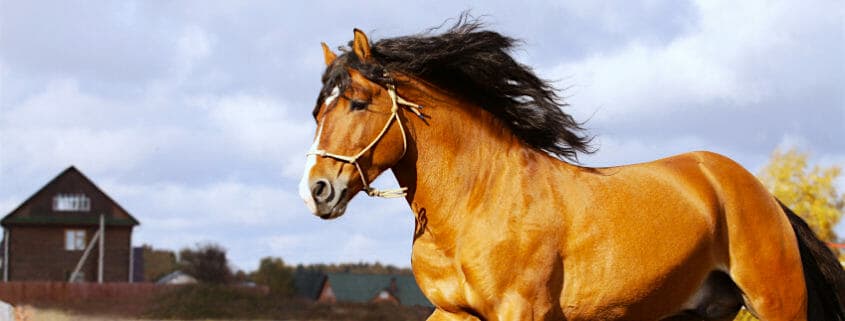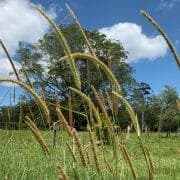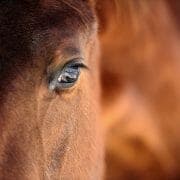Feeding Horses That Tie Up
Tying up is a painful condition for a horse and a frustrating one for you as an owner. Symptoms can range from severe muscle pain and distress, apparent colic, excessive sweating, elevated heart and respiration rates, a stiff gait, muscle tremors and a reluctance to move to more mild and elusive symptoms that just involve the horse feeling stiff, lazy or slightly lame.
Whether your horse suffers with severe tying up or a mild form, it will limit your horse’s performance and sense of well being, so the more you do to reduce the frequency and severity of bouts of tying up, the better your horse’s performance and health will be.
What is tying up?
Tying up, also called exertional rhabdomyolysis is a group of diseases that cause muscle damage and pain during and immediately following exercise. There are two main forms of tying up; polysaccharide storage myopathy (PSSM) which most commonly affects quarter horses, draft breeds and warmbloods; and recurrent exertional rhabdomyolysis (RER) which most commonly affects thoroughbreds as well as standardbreds and possibly arabians.
Horses affected by PSSM store abnormally high levels of glycogen in their muscles. These horses also accumulate abnormal amylase‐resistant polysaccharide in their fast twitch muscle fibres. Horses with PSSM appear to have no problem utilising the glycogen they have stored in their muscles when exercising. Why the storage of abnormally high levels of muscle glycogen causes muscle damage is still unknown. Recently a mutation in the gene for the skeletal muscle glycogen synthase enzyme (GYS1) has been identified as the primary cause of PSSM in quarter horses, draft horses and their crosses.
Horses affected by RER do not accumulate high concentrations of muscle glycogen, however they tend to exhibit abnormal and excessive muscle contractions, likely due to a heritable defect in calcium regulation within their cells. RER is often triggered by exercise and excitement, and it is well recognised that young fillies and horses with a nervous temperament are most affected.
Dietary management of horses with tying up
Both forms of tying up benefit from close dietary management. Following are 5 tips for formulating diets for horses with tying up:
Tip 1—Minimise starch and sugar intake. Diets high in starch and sugars (for example those that contain large amounts of grain based feeds) are well known to make tying up occur more frequently and severely. For horses with the PSSM form of tying up, we recommend that all feeds containing grains be removed from the diet completely. By ticking that your horse is affect by PSSM when you are filling in your horse’s details in FeedXL, all feeds that contain grain or grain by‐products are red listed to make it easy to avoid them.
For horses affected by the RER form of tying up, you should try to keep the amount of energy supplied by grain based feeds to 20% or less of the total digestible energy intake. To monitor this in FeedXL, simply hover your mouse over the Digestible Energy bar in the graph for a full breakdown of where the energy is coming from in the diet (see the screen shot below). If your grain based feeds are supplying more than 20% of the digestible energy and your horse continues to be affected by tying up, reduce the amount of these feeds in the diet.
Tip 2—Use high energy fibres and oils to supply energy.
Current recommendations suggest that horses with PSSM should receive 13% or more of their daily digestible energy intake as oil, while horses with RER on high energy diets (for example thoroughbreds in race training) should be receiving 20 to 25% of their daily digestible energy intake as oil or high fat feeds like rice bran. With these very high levels of oil, care must be taken to introduce it to the diet gradually to allow time for the horse and its gut to adapt to that level of oil feeding.
You should also keep in mind the omega 3 and omega 6 levels in the diet. If you use oils like corn or sunflower oil as the main oil in the diet, consider adding some flax/linseed (see blog article: Feeding Flaxseed) or a specialised omega 3 oil to balance omega 3 and omega 6 intakes.
Below are some examples of diets for horses with PSSM and RER that follow the first two tips given here.
PSSM Diet
This diet is for a 500 kg (1100 lb) Quarter horse in moderate work. Note that there is no grain or grain by products used in the diet below and that vegetable oil is providing 13 percent of the horse’s daily digestible energy requirement.
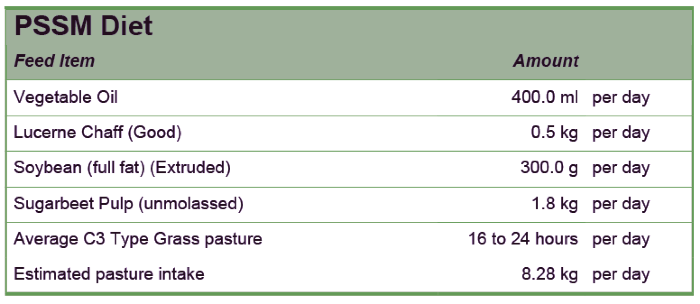
Example PSSM diet in printable (PDF) FeedXL results format
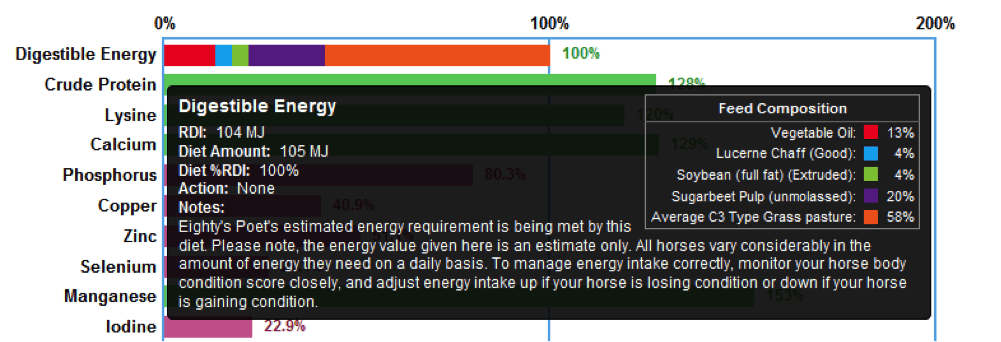
Digestible energy component of example PSSM diet in FeedXL
RER Diet
This diet is for a 500 kg (1100 lb) thoroughbred in hard work. Note that cereal grains are providing less than 20 percent of this horse’s daily digestible energy requirement and that vegetable oils and high fat feeds like rice bran are supplying 24% of the horse’s daily digestible energy requirement.
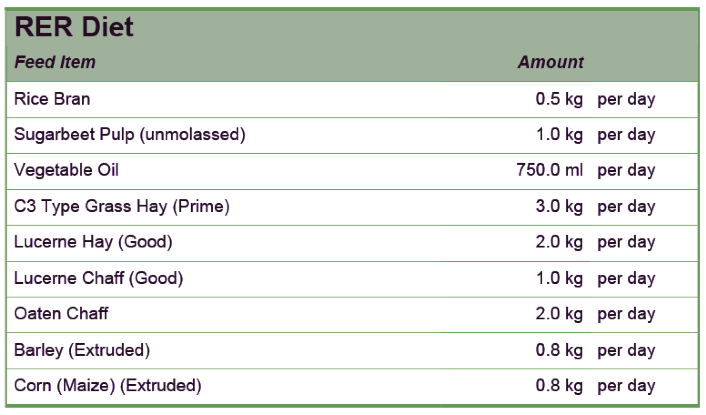
Example RER diet in printable (PDF) FeedXL results format
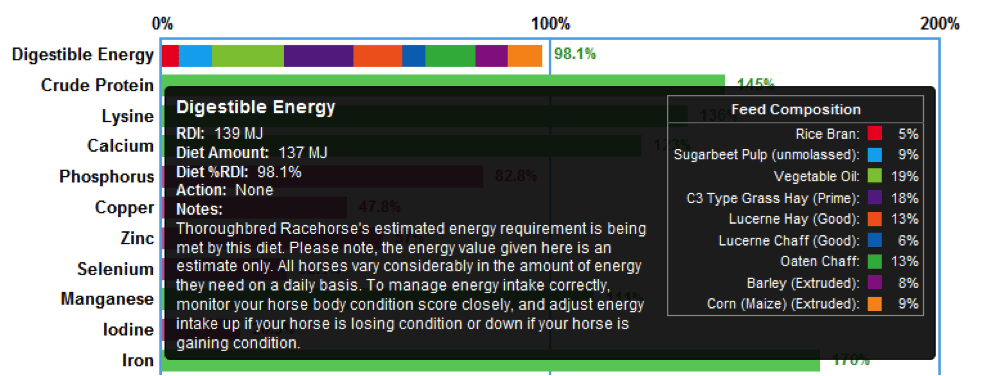
Digestible energy component of example RER diet in FeedXL
Tip 3—Use FeedXL to make sure the horse’s diet is balanced, and importantly that its requirements for the electrolyte minerals sodium, chloride, potassium and magnesium and requirements for the antioxidants selenium and vitamin E are met. Avoiding very high levels of protein is also a good idea.
Tip 4—Avoid oats. Oats seem to trigger the RER form of tying up in horses and particularly fillies more frequently than other grains (and we don’t know why). So for horses with RER that are still receiving some grain in their diet, use cooked corn, barley, rice or other grains you might have access to in place of oats.
Tip 5—Reduce or remove the grains and high energy fibre components from the diet on days off. Horses fed their full ration on rest days seem more likely to be affected by tying up once they resume work. You should increase the horse’s allocation of hay or amount of turn‐out time to compensate for the feed you have taken out of their diet on rest days. If your horse is prone to gaining too much weight, you should also reduce the amount of oil fed on days off.
Combine good feeding with good management
A well balanced diet containing the right amount of energy from fibre, starch and oil with all requirements for vitamins and minerals being met is only part of the puzzle for effectively managing both PSSM and RER forms of tying up.
Horses that suffer with tying up need to undergo a regular exercise program. Care must be taken to ensure horses are allowed to gradually build up fitness and horses should never be exerted beyond their level of fitness. Prolonged periods of stall confinement should be avoided, with horses that tie‐up being better off housed in larger pastures or yards so they can move around freely.
Rest days need to be managed carefully. While these horses certainly do need some time off to be horses, they should never be fully box rested, but instead should be walked or turned out to pasture for voluntary exercise on these days.
Nervous horses that are prone to RER should be managed to keep their stress levels down. Always housing them with a buddy, allowing them plenty of turn‐out time, feeding them first and maintaining as regular a daily routine as possible are a few things that might help.
Avoiding the knots
Following good dietary management by minimising or completely removing starch intake, providing 13 to 25% of daily energy intakes as oil or high fat feeds, meeting all essential vitamin and mineral requirements including those for electrolytes and antioxidants and providing a regular exercise routine that remains within the horse’s level of fitness will all help to keep your tying up prone horses’ muscles … untied.
Do you have a question or comment? Do you need help with feeding?
We would love to welcome you to our FeedXL Horse Nutrition Facebook Group. Ask questions and have them answered by PhD and Masters qualified equine nutritionists and spend time with like-minded horse owners. It’s free!
Click here to join the FeedXL Horse Nutrition Facebook Group

